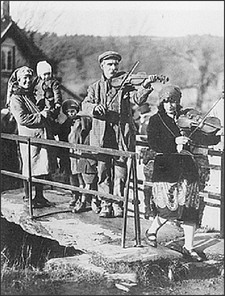




Copyright Warning
All texts/audio/still/motion picture images are strictly copyright to ValleyStream
Media 1980-2017 or to the stated contributor/
copyright holder/s or "unKn". Any unauthorised copying of any images or material
from this website for any use is strictly prohibited without written permission from
the image owners - owners of unknown images ("unKn") from this website please contact
us for fair use or image withdrawal. All rights reserved.

 border constructed superb Romani verde, embellished with 24 ct gold leaf dragon-heads,
bosh fiddles, harps, and grapes almost fit to eat. Only recently I discovered an
unknown Welsh verdo-builder, and this is as good a place as any to mention him -
J. Holly of Abergavenny. We came upon his relic van in a dire state high up on the
hillside around Buxton. It was owned by the late waggon Rai Tom Clarke and was propping
up a knackered dry stone wall. Unfortunately, it was too far gone to save, so we
yoged (fired) the flat-packed caravan in memory of the travellers who once inhabited
it. All these horse-drawn vehicles were used over time by our Welsh Kaule along with
their traditional zigairi (bender tents, also called beehive tents) or the more stately
cottage tent.
border constructed superb Romani verde, embellished with 24 ct gold leaf dragon-heads,
bosh fiddles, harps, and grapes almost fit to eat. Only recently I discovered an
unknown Welsh verdo-builder, and this is as good a place as any to mention him -
J. Holly of Abergavenny. We came upon his relic van in a dire state high up on the
hillside around Buxton. It was owned by the late waggon Rai Tom Clarke and was propping
up a knackered dry stone wall. Unfortunately, it was too far gone to save, so we
yoged (fired) the flat-packed caravan in memory of the travellers who once inhabited
it. All these horse-drawn vehicles were used over time by our Welsh Kaule along with
their traditional zigairi (bender tents, also called beehive tents) or the more stately
cottage tent.
In North and Mid Wales journeying was always harder, with fewer larger waggons on
the ground due to the harsh mountainous terrain. The heavier full size wooden verde
were seldom used and only seen along the coastal roadways or down in valley bottoms,
provided the road was level enough. The mountainous windy ways were horse-killers,
and only a brave Romani navigator or dinilo manush (foolish old man) would have attempted
to horse a full-size, fully loaded Burton van over the Horseshoe near Llangollen
or up n over the Crimea pass to Cwm Prysor. I travelled a light waggon with one of
the Welsh Griffiths over the last wilderness - Denbigh Moors - in the early 1980s,
and that was a gnat-bitten challenge n half.
Again, as in the South, in earlier times the mokhio (donkey) and
Interior of Mandylion © ValleyStream Media
the zigaira or tan (tent) were the preferred way to jal in the North, also two- or
four-wheeled carts and waggons with or without accommodation tops were favoured,
and from around the 1850s bowtops were used in many places, much the same as in the
hilly country of Northern England. The odd simple kite caravan descended Llanberis
Pass, and near Corwen an accommodation top over a four-wheeled Bill Wright pot waggon
was regularly used by the Gypsy Parson George Hall. You may have caught a glimpse
of a gilted Dunton Reading van passing within the walls of Conwy Castle or a Bolton
ledge built by Tong seen at Bangor. I believe the Boswells travelled the coastal
roads and on to Ynys Mon, Anglesey with a large bulbous verdo, and the Lancashire
Taylors were often seen around St Asaph well into the 1960s with a beautifully scrolled-out
bowtop. The Wood tribe could be seen around Corwen, Bala and Newtown with painted
bowtops and flat carts; a favourite achimasko tan (stopping place) was a blue slate
quarry up in the hills around Llanrhaeadr ym Mochnant.
The occasional hawker’s cart would have been seen in the villages, and we must not
forget the knife grinder’s barrow like the one Matthew Wood used, with “Glass n China
neatly repaired” scrolled across the signboard – clearly a manush of many skills.
– clearly a manush of many skills.
Esmeralda Lock, the most famous of the Romani juvia (women), used to encamp at Talacre
beach, Prestatyn in a small kite waggon (without a mollicroft), which we have recently
identified to be a very early Stubbs of Barrowden. She regularly horsed the green
and yellow van along the coast road and over to Chester way, as did her pal (brother)
Doovel and his Romni Carnation Boswell
Harry Turpin Wood © F Shaw






 border constructed superb Romani verde, embellished with 24 ct gold leaf dragon-
border constructed superb Romani verde, embellished with 24 ct gold leaf dragon- – clearly a manush of many skills.
– clearly a manush of many skills.